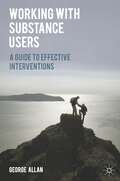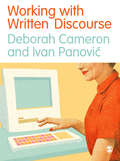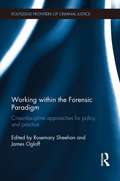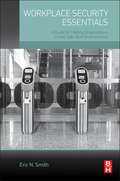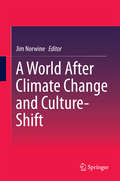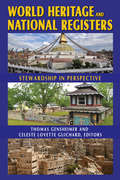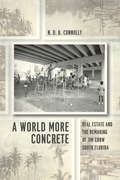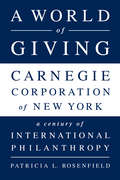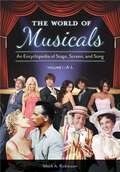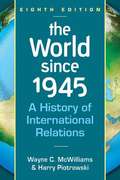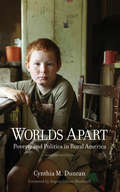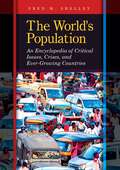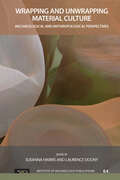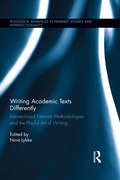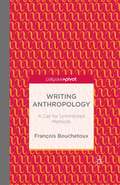- Table View
- List View
Working with Substance Users: A Guide to Effective Interventions
by George AllanSocial care and health professionals encounter people with drug and alcohol problems on a daily basis, but many feel ill-equipped to respond. Although people working across different professions will approach substance users from various perspectives, the knowledge and skills needed to intervene effectively are the same for all.With a strong emphasis on the core skills needed for practice, this up-to-date and accessible text provides a complete guide to working with substance users and their relatives. It covers the nature of problematic use and introduces theories as to why people experience substance problems and why people change. The book moves on to examine a number of effective interventions and how they can be applied, including assessment and care planning, pharmacological treatments and cognitive behavioural therapy. Distinctively, in addition to chapters on working with specific groups such as adolescents and involuntary service users, it also addresses the implications of parental problems for children and explores ways of helping adults affected by a relative's substance use.Supported throughout by case examples and activities to help apply theories and concepts to practice, this comprehensive text equips readers with the knowledge and skills needed to work with substance users.
Working with Written Discourse
by Deborah Cameron Ivan Panovic"An outstanding introduction to discourse analysis of written language in an age that is more and more characterized by multilingual, digital, and generically hybrid texts. In an accessible style, Working with Written Discourse illustrates how these texts can be analyzed employing a wide variety of approaches that are critical, multidisciplinary, and productive." - Professor Jaffer Sheyholislami, Carleton University "Comprehensive and up-to-the-minute in its discussion of areas like multimodality and the new media, without overlooking ‘older’ media and more conventional writing. I will recommend it highly to students at all levels." - Dr Mark Sebba, Lancaster University Addressing the practicalities of research, and embracing the complexity and variety of written forms of language, this book: grounds readers in a broad range of concepts, debates and relevant methods focuses on both theoretical questions and the ‘how to’ of analysis is loaded with practical activities and advice on the design and execution of research highlights computer-mediated communication and new media discourse, from text messages and tweets to mobile phone novels and online encyclopedias draws on data from international and multilingual communities. The perfect companion to Deborah Cameron's best-selling Working with Spoken Discourse, this book equips readers with practical and conceptual tools to ask questions about written discourse, and to analyse the huge variety of texts that make up our linguistic landscape. It is the essential guide for students of discourse analysis in linguistics, media and communication studies, and for social researchers across the social sciences.
Working with Written Discourse (PDF)
by Deborah Cameron Ivan Panovic"An outstanding introduction to discourse analysis of written language in an age that is more and more characterized by multilingual, digital, and generically hybrid texts. In an accessible style, Working with Written Discourse illustrates how these texts can be analyzed employing a wide variety of approaches that are critical, multidisciplinary, and productive." - Professor Jaffer Sheyholislami, Carleton University "Comprehensive and up-to-the-minute in its discussion of areas like multimodality and the new media, without overlooking ‘older’ media and more conventional writing. I will recommend it highly to students at all levels." - Dr Mark Sebba, Lancaster University Addressing the practicalities of research, and embracing the complexity and variety of written forms of language, this book: grounds readers in a broad range of concepts, debates and relevant methods focuses on both theoretical questions and the ‘how to’ of analysis is loaded with practical activities and advice on the design and execution of research highlights computer-mediated communication and new media discourse, from text messages and tweets to mobile phone novels and online encyclopedias draws on data from international and multilingual communities. The perfect companion to Deborah Cameron's best-selling Working with Spoken Discourse, this book equips readers with practical and conceptual tools to ask questions about written discourse, and to analyse the huge variety of texts that make up our linguistic landscape. It is the essential guide for students of discourse analysis in linguistics, media and communication studies, and for social researchers across the social sciences.
Working within the Forensic Paradigm: Cross-discipline approaches for policy and practice (Routledge Frontiers of Criminal Justice)
by Rosemary Sheehan James OgloffForensic work occurs across the criminal justice sector and the legal and health professions and intersects with work in a range of areas, such as child protection, family welfare, mental health, offending, disability and addictions, family violence programmes, juvenile justice and sexual assault centres. This book offers contemporary perspectives on forensic policy and practice from the range of practitioners working with people within the forensic domain and canvasses ideas about risk and offending behaviours together with ideas about effective responses to rehabilitation and recovery. The contributors to this proposed book are drawn from the practitioners, policy contributors, advocates and researchers in mental health, welfare, law, criminology, policing and health. Negligible attention has been paid to forensic policy and practice; this proposed book offers cross-national attention to how mental health, welfare and justice systems intersect, who they affect, and how practitioners structure effective responses for vulnerable people within the forensic domain. A particular strength of the book is its international focus, making it relevant to academics and practitioners who work in this field around the world.
Working within the Forensic Paradigm: Cross-discipline approaches for policy and practice (Routledge Frontiers of Criminal Justice)
by Rosemary Sheehan James OgloffForensic work occurs across the criminal justice sector and the legal and health professions and intersects with work in a range of areas, such as child protection, family welfare, mental health, offending, disability and addictions, family violence programmes, juvenile justice and sexual assault centres. This book offers contemporary perspectives on forensic policy and practice from the range of practitioners working with people within the forensic domain and canvasses ideas about risk and offending behaviours together with ideas about effective responses to rehabilitation and recovery. The contributors to this proposed book are drawn from the practitioners, policy contributors, advocates and researchers in mental health, welfare, law, criminology, policing and health. Negligible attention has been paid to forensic policy and practice; this proposed book offers cross-national attention to how mental health, welfare and justice systems intersect, who they affect, and how practitioners structure effective responses for vulnerable people within the forensic domain. A particular strength of the book is its international focus, making it relevant to academics and practitioners who work in this field around the world.
Workplace Security Essentials: A Guide for Helping Organizations Create Safe Work Environments
by Eric N. SmithWhether you are a business owner, department manager, or even a concerned employee, Workplace Security Essentials will show you how to improve workplace safety and security using real-life examples and step-by-step instructions. Every organization, be it large or small, needs to be prepared to protect its facilities, inventory, and, most importantly, its staff. Workplace Security Essentials is the perfect training resource to help businesses implement successful security measures, boost employee morale and reduce turnover, protect the company’s reputation and public profile, and develop the ability to process and analyze risks of all kinds. Workplace Security Essentials helps the reader understand how different business units can work together and make security a business function—not a burden or extra cost.Shows how to identify threats using tried-and-true methods for assessing risk in any size organizationUses real-world examples and scenarios to illustrate what can go wrong—and what can go right when you are preparedPrepares the reader for worst-case scenarios and domestic violence that may spill over into the workplaceProvides a clear understanding of various electronic systems, video surveillance, and burglar alarms, and how to manage a security guard force
A World After Climate Change and Culture-Shift
by Jim NorwineIn this book, an international team of environmental and social scientists explain two powerful current change-engines and how their effects, and our responses to them, will transform Earth and humankind into the 22nd-century (c.2100).This book begins by detailing the current state of knowledge about these two ongoing, accelerating and potentially world-transforming changes: climate change, in the form of global warming, and a profound emerging shift of normative cultural condition toward the assumptions and values often associated with so-called postmodernity, such as tolerance, diversity, self-referentiality, and dubiety replaced with certainty. Next, the contributors imagine, explain and debate the most likely consequent transformations of human and natural ecologies and economies that will take place by the end of the 21st-century.In 16 compellingly original, provocative and readable chapters, A World after Climate Change and Culture-Shift presents a one-of-a-kind vision of our current age as a “hinge” or axial century, one driven by the most radical combined change of nature and culture since the rise of agriculture at the end of the last Ice Age some 10 millennia ago. This book is highly recommended to scholars and students of the environmental and social sciences, as well as to all readers interested in how changes in nature and culture will work together to reshape our world and ourselves."I cannot think of a book more geared to advancing the art and science of geography." - Yi-Fu Tuan, J. K. Wright and Vilas Professor Emeritus of Geography, University of Wisconsin-Madison"Outstanding," "unique," and "exceptional timeliness of topic and ambition ofvision". - Richard Marston, University Distinguished Professor, Kansas State University; past president, Association of American Geographers
World Heritage and National Registers: Stewardship in Perspective
by Thomas R. GensheimerHistoric sites celebrate defining moments in history, memorialize important events and people, and contribute to the character of the locations where they are situated. Heritage designation, both globally and nationally, is an inherently contested issue. As detailed in this volume, concerns of politics and identity, criteria for designation, impacts on communities and sites, and challenges to management planning are central to any understanding of the process by which heritage sites are created, developed, and maintained. The idea for this volume originated at a symposium hosted by the Savannah College of Art and Design. Contributors address such topics as the need to revamp criteria for designation, the effect historic site recognition has on local communities, the challenges encountered in maintaining a site, and issues linked to specific political climates or actions and group identity. The contributors constitute an international cast of leading scholars, employees, and policy-makers, all of whom have had extensive experience with World Heritage and National Register site stewardship. The work will be an invaluable reference for historians, architects, and those committed to the preservation of national monuments.
World Heritage and National Registers: Stewardship in Perspective
by Thomas Gensheimer Celeste Lovette GuichardHistoric sites celebrate defining moments in history, memorialize important events and people, and contribute to the character of the locations where they are situated. Heritage designation, both globally and nationally, is an inherently contested issue. As detailed in this volume, concerns of politics and identity, criteria for designation, impacts on communities and sites, and challenges to management planning are central to any understanding of the process by which heritage sites are created, developed, and maintained. The idea for this volume originated at a symposium hosted by the Savannah College of Art and Design. Contributors address such topics as the need to revamp criteria for designation, the effect historic site recognition has on local communities, the challenges encountered in maintaining a site, and issues linked to specific political climates or actions and group identity. The contributors constitute an international cast of leading scholars, employees, and policy-makers, all of whom have had extensive experience with World Heritage and National Register site stewardship. The work will be an invaluable reference for historians, architects, and those committed to the preservation of national monuments.
A World More Concrete: Real Estate and the Remaking of Jim Crow South Florida (Historical Studies of Urban America)
by N. D. ConnollyMany people characterize urban renewal projects and the power of eminent domain as two of the most widely despised and often racist tools for reshaping American cities in the postwar period. In A World More Concrete, N. D. B. Connolly uses the history of South Florida to unearth an older and far more complex story. Connolly captures nearly eighty years of political and land transactions to reveal how real estate and redevelopment created and preserved metropolitan growth and racial peace under white supremacy. Using a materialist approach, he offers a long view of capitalism and the color line, following much of the money that made land taking and Jim Crow segregation profitable and preferred approaches to governing cities throughout the twentieth century. A World More Concrete argues that black and white landlords, entrepreneurs, and even liberal community leaders used tenements and repeated land dispossession to take advantage of the poor and generate remarkable wealth. Through a political culture built on real estate, South Florida’s landlords and homeowners advanced property rights and white property rights, especially, at the expense of more inclusive visions of equality. For black people and many of their white allies, uses of eminent domain helped to harden class and color lines. Yet, for many reformers, confiscating certain kinds of real estate through eminent domain also promised to help improve housing conditions, to undermine the neighborhood influence of powerful slumlords, and to open new opportunities for suburban life for black Floridians. Concerned more with winners and losers than with heroes and villains, A World More Concrete offers a sober assessment of money and power in Jim Crow America. It shows how negotiations between powerful real estate interests on both sides of the color line gave racial segregation a remarkable capacity to evolve, revealing property owners’ power to reshape American cities in ways that can still be seen and felt today.
A World More Concrete: Real Estate and the Remaking of Jim Crow South Florida (Historical Studies of Urban America)
by N. D. ConnollyMany people characterize urban renewal projects and the power of eminent domain as two of the most widely despised and often racist tools for reshaping American cities in the postwar period. In A World More Concrete, N. D. B. Connolly uses the history of South Florida to unearth an older and far more complex story. Connolly captures nearly eighty years of political and land transactions to reveal how real estate and redevelopment created and preserved metropolitan growth and racial peace under white supremacy. Using a materialist approach, he offers a long view of capitalism and the color line, following much of the money that made land taking and Jim Crow segregation profitable and preferred approaches to governing cities throughout the twentieth century. A World More Concrete argues that black and white landlords, entrepreneurs, and even liberal community leaders used tenements and repeated land dispossession to take advantage of the poor and generate remarkable wealth. Through a political culture built on real estate, South Florida’s landlords and homeowners advanced property rights and white property rights, especially, at the expense of more inclusive visions of equality. For black people and many of their white allies, uses of eminent domain helped to harden class and color lines. Yet, for many reformers, confiscating certain kinds of real estate through eminent domain also promised to help improve housing conditions, to undermine the neighborhood influence of powerful slumlords, and to open new opportunities for suburban life for black Floridians. Concerned more with winners and losers than with heroes and villains, A World More Concrete offers a sober assessment of money and power in Jim Crow America. It shows how negotiations between powerful real estate interests on both sides of the color line gave racial segregation a remarkable capacity to evolve, revealing property owners’ power to reshape American cities in ways that can still be seen and felt today.
A World More Concrete: Real Estate and the Remaking of Jim Crow South Florida (Historical Studies of Urban America)
by N. D. ConnollyMany people characterize urban renewal projects and the power of eminent domain as two of the most widely despised and often racist tools for reshaping American cities in the postwar period. In A World More Concrete, N. D. B. Connolly uses the history of South Florida to unearth an older and far more complex story. Connolly captures nearly eighty years of political and land transactions to reveal how real estate and redevelopment created and preserved metropolitan growth and racial peace under white supremacy. Using a materialist approach, he offers a long view of capitalism and the color line, following much of the money that made land taking and Jim Crow segregation profitable and preferred approaches to governing cities throughout the twentieth century. A World More Concrete argues that black and white landlords, entrepreneurs, and even liberal community leaders used tenements and repeated land dispossession to take advantage of the poor and generate remarkable wealth. Through a political culture built on real estate, South Florida’s landlords and homeowners advanced property rights and white property rights, especially, at the expense of more inclusive visions of equality. For black people and many of their white allies, uses of eminent domain helped to harden class and color lines. Yet, for many reformers, confiscating certain kinds of real estate through eminent domain also promised to help improve housing conditions, to undermine the neighborhood influence of powerful slumlords, and to open new opportunities for suburban life for black Floridians. Concerned more with winners and losers than with heroes and villains, A World More Concrete offers a sober assessment of money and power in Jim Crow America. It shows how negotiations between powerful real estate interests on both sides of the color line gave racial segregation a remarkable capacity to evolve, revealing property owners’ power to reshape American cities in ways that can still be seen and felt today.
A World More Concrete: Real Estate and the Remaking of Jim Crow South Florida (Historical Studies of Urban America)
by N. D. ConnollyMany people characterize urban renewal projects and the power of eminent domain as two of the most widely despised and often racist tools for reshaping American cities in the postwar period. In A World More Concrete, N. D. B. Connolly uses the history of South Florida to unearth an older and far more complex story. Connolly captures nearly eighty years of political and land transactions to reveal how real estate and redevelopment created and preserved metropolitan growth and racial peace under white supremacy. Using a materialist approach, he offers a long view of capitalism and the color line, following much of the money that made land taking and Jim Crow segregation profitable and preferred approaches to governing cities throughout the twentieth century. A World More Concrete argues that black and white landlords, entrepreneurs, and even liberal community leaders used tenements and repeated land dispossession to take advantage of the poor and generate remarkable wealth. Through a political culture built on real estate, South Florida’s landlords and homeowners advanced property rights and white property rights, especially, at the expense of more inclusive visions of equality. For black people and many of their white allies, uses of eminent domain helped to harden class and color lines. Yet, for many reformers, confiscating certain kinds of real estate through eminent domain also promised to help improve housing conditions, to undermine the neighborhood influence of powerful slumlords, and to open new opportunities for suburban life for black Floridians. Concerned more with winners and losers than with heroes and villains, A World More Concrete offers a sober assessment of money and power in Jim Crow America. It shows how negotiations between powerful real estate interests on both sides of the color line gave racial segregation a remarkable capacity to evolve, revealing property owners’ power to reshape American cities in ways that can still be seen and felt today.
A World More Concrete: Real Estate and the Remaking of Jim Crow South Florida (Historical Studies of Urban America)
by N. D. ConnollyMany people characterize urban renewal projects and the power of eminent domain as two of the most widely despised and often racist tools for reshaping American cities in the postwar period. In A World More Concrete, N. D. B. Connolly uses the history of South Florida to unearth an older and far more complex story. Connolly captures nearly eighty years of political and land transactions to reveal how real estate and redevelopment created and preserved metropolitan growth and racial peace under white supremacy. Using a materialist approach, he offers a long view of capitalism and the color line, following much of the money that made land taking and Jim Crow segregation profitable and preferred approaches to governing cities throughout the twentieth century. A World More Concrete argues that black and white landlords, entrepreneurs, and even liberal community leaders used tenements and repeated land dispossession to take advantage of the poor and generate remarkable wealth. Through a political culture built on real estate, South Florida’s landlords and homeowners advanced property rights and white property rights, especially, at the expense of more inclusive visions of equality. For black people and many of their white allies, uses of eminent domain helped to harden class and color lines. Yet, for many reformers, confiscating certain kinds of real estate through eminent domain also promised to help improve housing conditions, to undermine the neighborhood influence of powerful slumlords, and to open new opportunities for suburban life for black Floridians. Concerned more with winners and losers than with heroes and villains, A World More Concrete offers a sober assessment of money and power in Jim Crow America. It shows how negotiations between powerful real estate interests on both sides of the color line gave racial segregation a remarkable capacity to evolve, revealing property owners’ power to reshape American cities in ways that can still be seen and felt today.
A World More Concrete: Real Estate and the Remaking of Jim Crow South Florida (Historical Studies of Urban America)
by N. D. ConnollyMany people characterize urban renewal projects and the power of eminent domain as two of the most widely despised and often racist tools for reshaping American cities in the postwar period. In A World More Concrete, N. D. B. Connolly uses the history of South Florida to unearth an older and far more complex story. Connolly captures nearly eighty years of political and land transactions to reveal how real estate and redevelopment created and preserved metropolitan growth and racial peace under white supremacy. Using a materialist approach, he offers a long view of capitalism and the color line, following much of the money that made land taking and Jim Crow segregation profitable and preferred approaches to governing cities throughout the twentieth century. A World More Concrete argues that black and white landlords, entrepreneurs, and even liberal community leaders used tenements and repeated land dispossession to take advantage of the poor and generate remarkable wealth. Through a political culture built on real estate, South Florida’s landlords and homeowners advanced property rights and white property rights, especially, at the expense of more inclusive visions of equality. For black people and many of their white allies, uses of eminent domain helped to harden class and color lines. Yet, for many reformers, confiscating certain kinds of real estate through eminent domain also promised to help improve housing conditions, to undermine the neighborhood influence of powerful slumlords, and to open new opportunities for suburban life for black Floridians. Concerned more with winners and losers than with heroes and villains, A World More Concrete offers a sober assessment of money and power in Jim Crow America. It shows how negotiations between powerful real estate interests on both sides of the color line gave racial segregation a remarkable capacity to evolve, revealing property owners’ power to reshape American cities in ways that can still be seen and felt today.
A World of Giving: Carnegie Corporation of New York-A Century of International Philanthropy
by Patricia L RosenfieldThe age of international philanthropy is upon us. Today, many of America's most prominent foundations support institutions or programs abroad, but few have been active on the global stage for as long as Carnegie Corporation of New York. A World of Giving provides a thorough, objective examination of the international activities of Carnegie Corporation, one of America's oldest and most respected philanthropic institutions, which was created by steel baron Andrew Carnegie in 1911 to support the "advancement and diffusion of knowledge and understanding.” The book explains in detail the grantmaking process aimed at promoting understanding across cultures and research in many nations across the world.A World of Giving highlights the vital importance of Carnegie Corporation's mission in guiding its work, and the role of foundation presidents as thought and action leaders. The presidents, trustees, and later on, staff members, are the human element that drives philanthropy and they are the lens through which to view the inner workings of philanthropic institutions, with all of their accompanying strengths and limitations, especially when embarking on international activities. It also does not shy away from controversy, including early missteps in Canada, race and poverty issues in the 1930s and 1980s related to South Africa, promotion of area studies affected by the McCarthy Era, the critique of technical assistance in developing countries, the century-long failure to achieve international understanding on the part of Americans, and recent critiques by Australian historians of the Corporation's nation-transforming work there.This is a comprehensive review of one foundation's work on the international stage as well as a model for how philanthropy can be practiced in a deeply interconnected world where conflicts abound, but progress can be spurred by thoughtful, forward-looking institutions following humanistic principles.
The World of Musicals [2 volumes]: An Encyclopedia of Stage, Screen, and Song [2 volumes]
by Mark A. RobinsonThis wide-ranging, two-volume encyclopedia of musicals old and new will captivate young fans—and prove invaluable to those contemplating staging a musical production.Written with high school students in mind, The World of Musicals: An Encyclopedia of Stage, Screen, and Song encompasses not only Broadway and film musicals, but also made-for-television musicals, a genre that has been largely ignored. The two volumes cover significant musicals in easily accessible entries that offer both useful information and fun facts. Each entry lists the work's writers, composers, directors, choreographers, and cast, and includes a song list, a synopsis, and descriptions of the original production and important revivals or remakes. Biographical entries share the stories of some of the brightest and most celebrated talents in the business.The encyclopedia will undoubtedly ignite and feed student interest in musical theatre. At the same time, it will prove a wonderful resource for teachers or community theatre directors charged with selecting and producing shows. In fact, anyone interested in theatre, film, television, or music will be fascinated by the work's tantalizing bits of historical and theatre trivia.
The World Since 1945: A History Of International Relations (PDF)
by Wayne C. Mcwilliams Harry PiotrowskiNew emphasis on the impacts of globalization, events in the Middle East, and political and economic changes in East Asia - as well as new information and maps throughout - are among the features of this thoroughly revised edition. The text traces the political, economic, and ideological patterns that have evolved in the global arena from the end of World War II to the present, providing the background needed for a solid understanding of contemporary international relations.
Worlds Apart: Poverty and Politics in Rural America, Second Edition
by Cynthia M. DuncanFirst published in 1999, Worlds Apart examined the nature of poverty through the stories of real people in three remote rural areas of the United States: New England, Appalachia, and the Mississippi Delta. In this new edition, Duncan returns to her original research, interviewing some of the same people as well as some new key informants. Duncan provides powerful new insights into the dynamics of poverty, politics, and community change. "Duncan, through in-depth investigation and interviews, concludes that only a strong civic culture, a sense among citizens of community and the need to serve that community, can truly address poverty. . . . Moving and troubling. Duncan has created a remarkable study of the persistent patterns of poverty and power."—Kirkus Reviews "The descriptions of rural poverty in Worlds Apart are interesting and read almost like a novel."—Choice
The World's Population: An Encyclopedia of Critical Issues, Crises, and Ever-Growing Countries
by Fred M. ShelleyThis one-volume encyclopedia examines key topics, major world players, and imminent problems pertaining to the world's ever-growing population.According to the United Nations, the population of our planet reached 7 billion people in 2011. What areas of the world have the most people? What measures, if any, are in place to control the population? Why is Europe's population shrinking, while the rest of the world is growing? This eye-opening encyclopedia answers questions like these by examining significant issues and topics relating to the population and exploring profiles of the most populated countries and cities of the world. More than 100 alphabetically arranged entries focus on such topics as census, demography, megacity, overpopulation, and urban sprawl. Author Fred M. Shelley, an accomplished academic in the field of environmental sustainability, reveals the steps taken by major cities such as Rio de Janeiro, Paris, Tokyo, Beijing, Mexico City, Seoul, Manila, and New Delhi in handling their population, and what is being done in China and other countries to prevent overcrowding. The text includes a discussion of how factors like migration patterns, war, and disease impact population change. This comprehensive encyclopedia also includes primary document excerpts from court cases, legislation, and political speeches relating to population issues.
Wrapping and Unwrapping Material Culture: Archaeological and Anthropological Perspectives (UCL Institute of Archaeology Publications)
by Susanna Harris Laurence DounyThis innovative volume challenges contemporary views on material culture by exploring the relationship between wrapping materials and practices and the objects, bodies, and places that define them. Using examples as diverse as baby swaddling, Egyptian mummies, Celtic tombs, lace underwear, textile clothing, and contemporary African silk, the dozen archaeologist and anthropologist contributors show how acts of wrapping and unwrapping are embedded in beliefs and thoughts of a particular time and place. Employing methods of artifact analysis, microscopy, and participant observation, the contributors provide a new lens on material culture and its relationship to cultural meaning.
Wrapping and Unwrapping Material Culture: Archaeological and Anthropological Perspectives (UCL Institute of Archaeology Publications #64)
by Susanna Harris and Laurence DounyThis innovative volume challenges contemporary views on material culture by exploring the relationship between wrapping materials and practices and the objects, bodies, and places that define them. Using examples as diverse as baby swaddling, Egyptian mummies, Celtic tombs, lace underwear, textile clothing, and contemporary African silk, the dozen archaeologist and anthropologist contributors show how acts of wrapping and unwrapping are embedded in beliefs and thoughts of a particular time and place. Employing methods of artifact analysis, microscopy, and participant observation, the contributors provide a new lens on material culture and its relationship to cultural meaning.
Writing Academic Texts Differently: Intersectional Feminist Methodologies and the Playful Art of Writing (Routledge Advances in Feminist Studies and Intersectionality #16)
by Nina Lykke Anne Brewster Kathy Davis Redi Koobak Sissel Lie Andrea PetöThis edited volume combines cutting-edge research on feminist and intersectional writing methodologies with explorations of links between academic and creative writing practices. Contributors discuss what it means for academic writing processes to explore intersectional in-between spaces between monolithic identity markers and power differentials such as gender, race, ethnicity, class, sexuality and nationality. How does such a frame change academic writing? How does it make it pertinent to explore new synergies between academic and creative writing? In answer to these questions, the book offers theories, methodologies, political and ethical considerations, as well as reflections on writing strategies. Suggestions for writing exercises, developed against the background of the contributors' individual and joint teaching practices, will inspire readers to engage in alternative writing practices themselves.
Writing Academic Texts Differently: Intersectional Feminist Methodologies and the Playful Art of Writing (Routledge Advances in Feminist Studies and Intersectionality)
by Nina LykkeThis edited volume combines cutting-edge research on feminist and intersectional writing methodologies with explorations of links between academic and creative writing practices. Contributors discuss what it means for academic writing processes to explore intersectional in-between spaces between monolithic identity markers and power differentials such as gender, race, ethnicity, class, sexuality and nationality. How does such a frame change academic writing? How does it make it pertinent to explore new synergies between academic and creative writing? In answer to these questions, the book offers theories, methodologies, political and ethical considerations, as well as reflections on writing strategies. Suggestions for writing exercises, developed against the background of the contributors' individual and joint teaching practices, will inspire readers to engage in alternative writing practices themselves.
Writing Anthropology: A Call for Uninhibited Methods
by F. BouchetouxA call for new methods for anthropology, this book explores the nature of anthropological knowledge and the conditions of integration and communication with people. Starting with an analysis of anthropologists' guilt, Fan addresses issues of reflexivity, reciprocity, and respect, then builds on this to evaluate how researchers generate knowledge.
